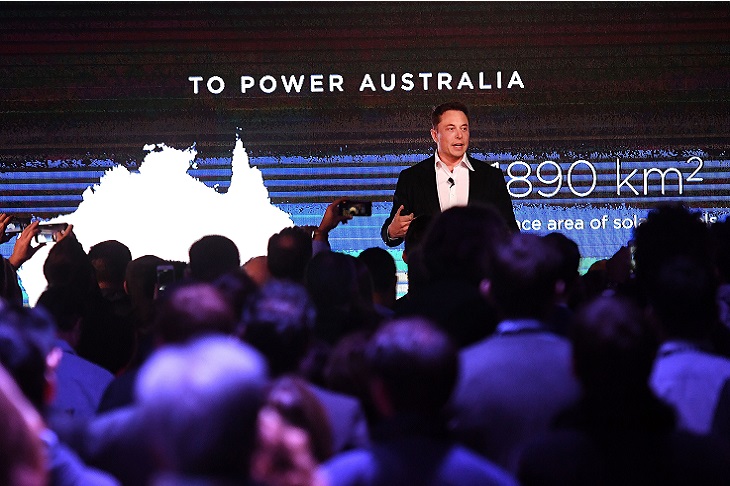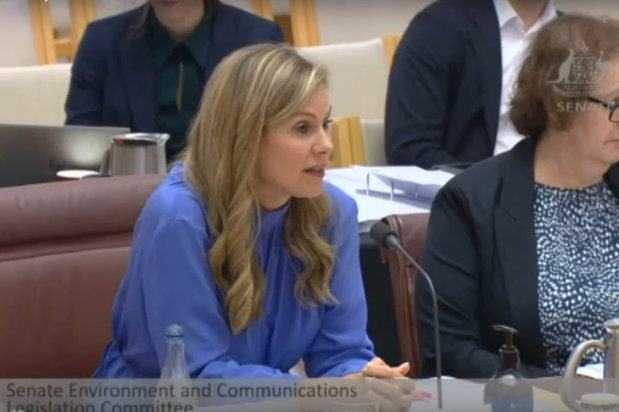Clearly, some things are no longer up for discussion.
In a current TV ad from the Clean Energy Council, there is an old guy on a seat who sees a battery the size of carry-on luggage wheeled into the local country fire station.
He comments, ‘As if that battery’s going to make that much difference!’
‘Well, it’s going save us some money. When the sky is black and the bushfires are rushing in,’ says the guy with Yackandandah Firefighter emblazoned on his work shirt, and with a meat pie in hand, ‘that battery’s going to help us save lives. Nearly 30 per cent of Australia’s power is renewable. And soon it’s gunna be 50.’
‘Yeah but…’ says the old guy.
He is cut off by the mellifluous narrator saying, ‘No more, “yeah but…”, renewable energy is here now.’
The firefighter crunches down through the aluminium foil under his pie. The foil will likely be made in China (and the faux firefighter needs instruction on how to eat a meat pie in a truly Aussie style).
In the ad, the company logo is indicated on the battery, but it is not clear whether its usable energy is 6 or 12 kWh. Our national electric energy use per year is 229 billion kWh which is about 24 kWh per person per day. So the fire station battery might indeed be useful in keeping a light on and recharging some phones for some hours. Their truck batteries would be more portable. ‘Yeah but’ it’s not clear how it could save them money, though it’s a very good idea for an isolated fire station to have backup energy.
A Tesla home battery storage system with about 14 kWh of energy costs about $14,000. That would be about enough for a small family, who all go to bed early on a mild night. But as the Clean Energy Council points out, though over 3 million Australian homes have rooftop solar, maybe 37,000 have battery storage. Still, over 98 per cent of Australian households, who take the trouble or perks of having rooftop solar, don’t find the economics of batteries attractive. ‘Yeah but…’ barely 4 in 1,000 Australian households have battery backup with their solar.
The Clean Energy Council is right – to a point. About 30 per cent of Australian households have rooftop solar, perhaps the largest proportion in the world. Our total renewables now contribute about 70 billion kWh, a third of our electrical energy. Though 25 per cent of our renewables come from hydro – those wicked dams which previous generations dared build – there has been a surge in rooftop solar over 15 years and it provides quite a chunk of Australian power when the sun is high. How much power do we store for when the clouds come over, and when night inevitably falls? Very little.
You can see on the Australian Energy Market Operator (AEMO) website the solar power contribution, but you cannot see anything from batteries – either household or utility scale – because it is too negligible to show on their graphics. It may be useful as a short-term backup.
Baseload power has to chug along, being constantly undermined by the virtuous rooftops. Steady baseload has to bid for fractions of a day being undermined by this skittish source. Meanwhile, the economics of fossil power stations heading south until the long winter’s nights give them some reprieve. And how much baseload coal power is shed because it must be kept reliably chugging along? Do intermittent renewables even reduce baseload fossil fuel emissions? Is the contribution of renewables relevant without backup?
The AEMO only pays lip service to reliability when it buys power from minute to minute – providers of solar power jump to the front of the queue when it suits them, then abandon the field every night. More so in winter. Every time a cloud drifts over a vast solar farm, its power output is reduced to a fraction of its capacity.
This is without consideration of not just the quantity of power, but its quality to meet the requirements of the AC national grid: the heavy mechanical turbines of steam and hydropower deliver electricity at 50 Hz and have momentum and inertia to stick to this required frequency. Without a large proportion of power sources having such inertia (solar and wind have inherently none), the whole system becomes unstable. Synchronous condensers and shunt reactors must be added to stabilise the grid, providing some inertia to keep the system within AC frequency and voltage requirements. They are an extra expense.
‘Yeah but…’ there is no doubt that an increased penetration of renewables would need flexible backup by storage (batteries or pumped hydro) or dispatchable power (hydro to some extent but mainly open cycle gas turbines).
Batteries! Bjorn Lomborg points out that ‘all the batteries in Europe could store power for just 1 minute and 21 seconds of the continent’s average electricity demand’. Utility scale battery storage in the USA increased rapidly to a total of 2,600 MW last year, still about 0.5 per cent of its combined wind and solar at 495,000 MWh production.
Australia is the ‘great leader’: in 2017 we installed the largest lithium-powered battery in the world with 100 MW capacity, then pressed on to 150 MW so it could power Adelaide for 3 minutes rather than 2 minutes if the network failed, as it had before. Hornsdale can now hold 194 MWh of electrical energy, but Australia needs 627,000 MWh per day.
The Victorian Big Battery outside of Geelong, with 300 MW power capacity and 450 MWh of energy, uses 212 Tesla ‘megapacks’ each the size of a shipping container. After a protracted fire led to updating its safety procedures, it is now running. The Victorian government renewable energy page assures us its 450 MWh, if fully charged, could power 1 million homes for 30 minutes. How many homes are there in a state of 6 million people? How would this power be accessible to the network if the power doesn’t have the right voltage and frequency characteristics?
Origin Energy proposes a 700 MW battery to replace Eraring power station which had 4 times that power production capacity every hour: good luck at a quarter of an hour after sunset in Sydney on a winter’s evening! AGL proposes 1,000 MW of batteries across several sites. A billionaire briefly proposes a 2,000 MW battery as part of a power solution for closing more baseload power. Another couple of billionaires insouciantly propose a 10,000 MW battery as part of the $30 billion Sun Cable project in the Northern Territory. This project would deliver 8.6 million tonnes of carbon emission abatements per year but this would be barely 3 per cent of the abatements from our uranium exports according to DFAT. Scaled up from the Victorian experience, that would be over 7,000 Tesla megapacks – that’s a lot of lithium, nickel, and cobalt. Would it cost $10 billion to replace every 10 years and where would the waste go? Where would the batteries come from?
Lithium prices have fluctuated wildly in recent years but the recent increase in price to $US40,000 per tonne will increase the incentive to mine it and improve supply which is currently being outstripped by demand. This demand is expected to go up at least ten-fold to 3 million tonnes per year driving up the price of batteries mainly for EVs but also for utility scale energy storage. Elon Musk himself has warned of a looming nickel shortage. The environmental impact of brine management led to Serbia cancelling Rio Tinto’s massive lithium mining project there. There will be many other environmental issues as the demand for lithium soars.
There are Tesla ‘Gigafactories’ for lithium battery manufacture with 94 in China, 2 in Europe, 4 in the USA; the projection by 2030 is China 130, USA 10 and Europe 38 planned for car batteries. Australian green new jobs – probably zero. But even with all these, will there be enough lithium and other metals to go around? Forbes favours investment in lithium mining as they see a crisis within a year – it’s one minute to midnight! A lithium battery can store 150 watts per kilogram, but it is estimated if electric vehicles have a 50 per cent plus market share by 2030 they will need 2,700,000 MWh of storage which would require 20 million tons of lithium per year. Known mineable lithium is in the range 30-90 million tons. ‘Yeah but…’ big batteries are going to get more expensive.
They say ‘the stone age didn’t end for a lack of stones’. The age of lithium battery storage as a ‘sustainable’ solution for intermittent wind and solar never arrived. This age is in the past while some are still dreaming of its future.
In 2019 the Nobel prize in Chemistry was shared by 3 men who were instrumental in the invention of lithium rechargeable batteries, including Goodenough who was 97, the oldest Nobel recipient ever, when he won for his work in the 1980s. Since then rechargeable batteries have been continually refined to those we use today in our electronic devices but major breakthroughs are slow coming.
I sent a question to the Yackandandah CFA: ‘Are you happy about the Clean Energy Council ad which depicts your firefighter extolling battery backup for renewable energy, whilst endeavouring to chomp through the foil under his pie?’
I’m still waiting on a response. ‘Yeah but…’
Dr Richard Peppard is a senior neurologist and the Liberal Democrats candidate for the upcoming federal election in the seat of Melbourne.
Got something to add? Join the discussion and comment below.
Get 10 issues for just $10
Subscribe to The Spectator Australia today for the next 10 magazine issues, plus full online access, for just $10.


























Comments
Don't miss out
Join the conversation with other Spectator Australia readers. Subscribe to leave a comment.
SUBSCRIBEAlready a subscriber? Log in